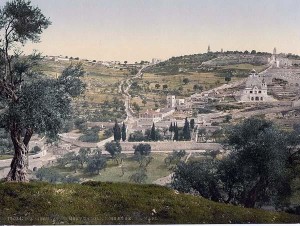How and Why the Imagery of Zechariah 14 Intentionally Mirrors Genesis 1:1-10: The Symbolism of Zechariah 14 has a Unifying Theme depicting the Establishment of Israel’s Sovereignty over Greece and the Reestablishment of the Law in the Imagery of the Creation of the Earth in Genesis 1:1-10.
The language of Zechariah 14 may seem random and bizarre. However, there is nothing random about the symbolism in this chapter. In Zechariah 14 there is a unifying theme that is certainly present but easily missed: The miracles of Zechariah 14 are creation motifs symbolizing Israel’s sovereignty over Greece and the reinstitution of the Law in the image and language of the creation of heaven and earth in Genesis 1. In other words, Zechariah 14 is a creation account depicting the reestablishment of the Law and the subsequent creation of a new sovereign kingdom, Israel, in such a way as to point to Genesis 1. See Zechariah 14 Fulfilled in the Maccabean Wars: A Preterist Commentary.
In Genesis 1:2 the preformed earth begins as a formless water world. Below we will explain how Zechariah 14:2, 4-5 is Biblically linked to the primordial water-world state of the earth in Genesis 1:2. In the earth’s preformed state, Genesis 1:2 says that all was dark. This primitive darkness is depicted in Zechariah 14:6: “On that day there will be no light[.]” Then at the start of creation, the Spirit of God hovers over the surface of the waters in Genesis 1:2. In the commentary below we will show that when the Spirit of God hovered over the waters in Genesis 1:2 that this was the first recorded incidence in the Bible in which God had come on the clouds as he does in Zechariah 14:5. As His first act of creation, God created light in Genesis 1:3. An allusion to the creation of light is mentioned in Zechariah 14:7: “When evening comes, there will be light.” This miraculous light in Zechariah 14:7 that shines in the darkness of the evening mirrors the creation of light that shone in the primordial darkness in Genesis 1:3. In Genesis 1:9-10 God parts the waters below heaven to create the earth by allowing dry land to surface. The separation or parting of the waters is depicted in Zechariah 14:8-10. The creation account of Zechariah 14 ends with the parting of the waters to create the new earth which is the new sovereign Israel of Zechariah 14:10 which had reinstituted the practice of the Law three years after the Temple had been seized by the Greeks and desecrated.

According to Genesis1:2 at the start of creation, “[t]he earth was formless and void, and darkness was over the surface of the deep . . .”
Genesis 1:2: “Now the Earth was Formless and Empty, Darkness was over the Surface of the Deep, and the Spirit of God was hovering over the Waters.”
In Zechariah 14:2 there is a subtle Biblical link between this verse and the water-world or flooded state of the earth before its creation in Genesis 1:2. According to Zechariah 14:2 God “will gather all the nations to Jerusalem to fight against it.” Though Zechariah does not depict this foreign assault as a metaphorical flood, the Bible often uses flood imagery to represent foreign conquest like that mentioned in v.2. This flood motif along with its implicit meaning denoting conquest by foreign armies is very clearly implied and often repeated throughout the Bible (Daniel 7; 9:26; 11:10, 40; Psalm 65:7; 144:7, Isaiah 8:7-8; 17:12; 60:5; Jeremiah 46:7-8; 47:1-2; 51:55-56; Ezekiel 26:3; Nahum 1:8; Joel 2:9; Revelation 17:15). See In the Bible “Earth” Signifies the Specific Land Addressed While “Sea” Symbolizes Foreign Nations. Thus the gathering of all the nations to fight against Jerusalem during the Maccabean Wars of the second century B.C. in Zechariah 14:2 is the metaphorical flooded or water-world state of the primordial earth. This implicit flood which represents the conquest of the Israel, the earth, by the Seleucids, the sea, represents a return to the primordial water-world state of the world before its creation in Genesis 1:1-2.
At the beginning of creation in Genesis 1:2 “the Spirit of God hovers over the waters.” According to Psalm 104 when God hovered over the waters in Genesis 1:2 this was the first occasion in which God was said to have come on the clouds of heaven in the Bible. Psalm 104 is a retelling of Genesis 1. Instead of repeating Genesis 1:2 by saying that the Spirit of God moved or hovered over the waters, Psalm 104:3 says that God came on the clouds at this time: “He makes the clouds his chariot and rides on the wings of the wind [emphasis mine].” Here Psalm 104 implies that at the start of creation in Genesis 1, God had come on the clouds of heaven.

The darkening of the heavenly lights by thick cloud cover in conjunction with the destruction of a city implies that God had come on the clouds in judgment.
The clouds that serve as the Lord’s chariot in Genesis 1:2 are presumably created by the separation or evaporation of the waters in Genesis 1:6-8. The clouds formed by the separation of the waters above from the waters below coalesce to become the clouds upon which the Lord rides at the beginning of creation. The coming of the Lord on the clouds of heaven is an often repeated motif throughout the Old and New Testaments. The coming of the Lord on the clouds of heaven is implied in Zechariah 14:5: “Then the LORD my God will come, and all the holy ones with him.” The second century B.C. fulfillment of this event appears to be mentioned in 2 Maccabees 5:2-3. Here a mass-vision of an angelic army was seen in the sky over Jerusalem at the start of the Maccabean Wars. This army of angels in the sky as it is recorded in 2 Maccabees is seemingly identical or nearly identical to historical descriptions of the initial aspect of the Parousia or second coming. Throughout the Gospels Jesus often predicted that He would come on the clouds of heaven at the end of the age just as God was often reported to have done throughout the Old Testament. According to Tacitus and Josephus a mass-vision of a similar angelic army was also reported in the sky over Israel at the start of the Jewish War.1 See Jesus, the Son of Man, was LITERALLY Seen in the Clouds in A.D. 66.
During the parousia or second coming, Jesus said that He would also come on the clouds. As stated above according to Psalm 104:3 and Genesis 1:2, the Spirit of God hovered over the waters during the creation of heaven and earth. Similarly, the second coming also marked the creation of a new heaven and earth foretold in 2 Peter 3:13 and Revelation 21:1. Therefore, when Jesus came on the clouds of heaven during His second coming, this appearance was a creation motif pointing to Genesis 1:2-8 when the Spirit of God came on the clouds at the start of the creation.
The same message of a new heaven and earth is implicit in Zechariah 14 with the coming of the Lord during the Maccabean Wars of the second century B.C. mentioned in Zechariah 14:5. Here the Lord seemingly also comes on the clouds of heaven at the start of a new heaven and earth at the reinstitution of the Law during the reconsecration of the Temple in 164 B.C. and the subsequent establishment of a new sovereign Israel shortly thereafter.
If when the Spirit of God hovered over the waters in Genesis 1:2 and the coming of the Lord on the clouds of heaven in Zechariah 14:5 are analogous events, how did the Lord move over waters in Zechariah 14:5? According to Genesis 1 the earth was in a flooded state before its creation. As stated above, floods are often used in the Bible to symbolize conquest by foreign armies. See In the Bible “Earth” Signifies the Specific Land Addressed While “Sea” Symbolizes Foreign Nations. Furthermore, in the Old and New Testaments whenever God or the Son of God was said to come on the clouds that often meant that the Lord was going to come in conquest upon a rebellious nation in the midst of a foreign army as is exemplified in Nahum 1:3.2 Therefore, when God moved over the waters during His coming in Zechariah 14:5 at the time of the Maccabean Wars, these waters are implied by the presence of the Greek Army and its dominion over Israel in the second century B.C at the start of the Maccabean Wars. In other words, this foreign empire was the flood waters that point to the precreation water-world of Genesis 1.
While the Spirit of God moved over the waters, there was “darkness over the surface of the deep” according to Genesis 1:2. This primordial darkness is referenced in Zechariah 14:6: “In that day there will be no light; the luminaries will dwindle.”3 The fact that the luminaries; the sun, moon and stars; do not give their light in Zechariah 14:6 points to Genesis 1:1-2 in which there was darkness before God created light in Genesis 1:3 and the luminaries in Genesis 1:14-19. Then in Zechariah 14:7, Zechariah says, “It will be a unique day, without daytime or nighttime—a day known to the LORD.” The fact that Zechariah says that the day without light is a unique day without daytime or nighttime is a poignant allusion to the precreation state of heaven and earth in Genesis 1:1-2 in which before the creation of light and the first day, all was dark. This darkness before creation is the “unique day, without daytime or nighttime” in which there is “no light [and] the luminaries …dwindle” pointing to the state of the earth in Genesis 1:1-2 before light, the sun, moon and stars had been made.
The darkness of Zechariah 14:6 in which the sun, moon and stars are not visible which mirrors the darkness of Genesis 1:2 is also an omen pointing to the presence of the Glory Cloud, the hallmark of the coming of the Lord on the clouds of heaven. According to Genesis 1:2 amidst the darkness mentioned in this verse, the Spirit of God is said to move over the waters. Remember that Psalm 104:3 says that when God moved over the waters in Genesis 1:2, He had come on the clouds of heaven. The clouds upon which the Lord rides when He comes in judgment or while in the act of creation is called the Glory Cloud.
The presence of God on the clouds of heaven is often marked by dark clouds and fire (Exodus 40:34-38; Leviticus 16:2; 2 Samuel 22:8-15; Isaiah 66:15-16; Psalm 18:6-16; 50:3; 97:1-5; 144:5; Ezekiel 1:4). These clouds with fire are called the Glory Cloud. At the coming of the Lord on the Glory Cloud the sun, moon and stars are darkened:
Before them [an invading army] the earth shakes, the heavens tremble, the sun and moon are darkened, and the stars no longer shine. The Lord thunders at the head of his army; his forces are beyond number, and mighty is the army that obeys his command. The day of the Lord is great; it is dreadful. Who can endure it [emphasis mine] (Joel 2:10-11)?
As is made clear in Ezekiel 32:7-9, the darkening of the sun, moon and stars is accomplished by the blanketing effect of the presence of the Glory Cloud overhead:
When I snuff you out, I will cover the heavens and darken their stars; I will cover the sun with a cloud, and the moon will not give its light. All the shining lights in the heavens I will darken over you; I will bring darkness over your land, declares the Sovereign Lord. I will trouble the hearts of many peoples when I bring about your destruction among the nations, among lands you have not known [emphasis mine].
Here one can see how the darkness of Zechariah 14:6 in which the sun, moon and stars are not visible which mirrors the darkness of Genesis 1:2 is a direct result of the darkening of the sun, moon and stars by the blanketing effect of the thick cloud cover of the Glory Cloud which signifies the coming of the Lord on the clouds of heaven mentioned in Zechariah 14:5.
Genesis 1:3: “And God said, “Let there be Light[!]”
Zechariah 14:7 then goes on to say, “When evening comes, there will be light.” The fact that light emerges miraculously in the darkness of the evening points to the first step of creation mentioned in the following verse in Genesis, Genesis 1:3: “And God said, ‘Let there be light,’ and there was light.”
Genesis 1:9: “And God said, ‘Let the Water under the Sky be gathered to One Place, and let Dry Ground Appear.”
Having explained how foreign conquest is frequently depicted in flood imagery and that this motif symbolizes a return to the primordial water-world state of the earth before its creation in Genesis 1:1-2, let us now take a look at the splitting of the Mt. of Olives in Zechariah 14:4 and its relationship to Genesis 1. Mountain is another word for city or kingdom in the Bible. There are many examples of this implicit meaning found in Scripture of which Psalms 2:6, Psalms 48:1, Isaiah 66:20, Jeremiah 51:25, and Joel 3:17 are a few examples. Furthermore, as explained above waters or sea are also terms used in the Bible to represent a nation, nations or a kingdom or kingdoms. Thus, sea, waters and mountain or mountains are virtually synonymous Biblical symbols. Therefore, the parting or splitting of the Mt. of Olives and the parting of the Red Sea each signifies the same symbolic message. These two miracles point to the creation of a new earth by way of the separation of the waters in Genesis 1:9-10. In Genesis 1:9-10 the waters under heaven were parted or separated to allow dry land, the earth, to appear. It was the parting or separation of the waters in these verses that ultimately created or exposed the earth. In the same way that the parting of the Red Sea miraculously symbolized the creation of a new covenant and a new sovereign Israel soon to be occupied by the former Hebrew slaves from Egypt, the splitting of the Mt. of Olives also represents the creation of a new earth. This new earth is the new sovereign Israel who overthrew their Greek overlords during the Maccabean Wars and reestablished the practice of the Law after the Temple was seized and desecrated by the Greeks at the start of this war.

According to Exodus 14:22 the parting of the Red Sea and the passage of the saints through the Mt. of Olives may have appeared surprisingly similar to the parties involved.
Having explained how the parting of the Red Sea and the splitting of the Mount of Olives both symbolize the separation of the waters in Genesis 1:9-10, it is interesting to note that the parting of the Red Sea and the passage of the saints through the Mt. of Olives may have even appeared surprisingly similar to the parties involved. According to Exodus 14:22 when the Israelites passed through the Red Sea on dry land there was a “wall of water on their right and on their left.” Similarly, when the Jews of Jerusalem passed through the Mt. of Olives half of the mountain would have formed a wall to their right and half would have also formed a wall to their left.

Above is a photograph of the Mt. of Olives [1890-1900]. Notice the similarities in appearance between the division of this mountain and the image of the parting of the Red Sea depicted above it.
As stated above, the creation account laid out in Genesis 1 is retold in Psalm 104. The introductory steps of creation laid out in Genesis 1:1-8 including the spirit of God hovering over the waters with the clouds as His chariot is repeated in Psalm 104:1-4. Then vs. 5-9 describe the creation of the earth by the separation of the waters under heaven:
He established the earth upon its foundations, So that it will not totter forever and ever. You covered it with the deep as with a garment; The waters were standing above the mountains. At Your rebuke they fled, At the sound of Your thunder they hurried away. The mountains rose; the valleys sank down To the place which You established for them. You set a boundary that they [the waters] may not pass over, So that they will not return to cover the earth [emphasis mine].4
Notice that in v. 8 the mountains are said to rise amidst the separation of the waters in vs. 5-9. This rising of the mountains is depicted in Zechariah 14:10 in which Jerusalem, the Lord’s holy mountain, is raised up. The earth was “without form and void” in Genesis 1:2 because it was a water world lacking the mountains and valleys of dry land before the separation of the waters in Genesis 1:6-10. In Zechariah 14:8-10 the creation of the new earth, the new Jerusalem, mentioned in Zechariah 14:10 is metaphorically portrayed as if it were a volcanic island rising out of the sea causing the waters of the sea to separate and run down the island slopes as the dry land emerges above the ocean’s surface.5

The separation of the waters in Genesis 1:9-10 depicts the earth rising out of the primordial sea like a volcanic island which causes the waters of the sea to separate and run down each side of the exposed surface as it rises over the surface of the water.
**NOTE** This is a NEW website. If you liked this article share it, like us on Facebook and follow on Twitter. Thank You!
For more compelling evidence of an old earth through sound Biblical exegesis see the following articles 1) The Earth is More than 6000 Years Old: How Young Earth Creationists have Misinterpreted the Bible 2) Why Isaiah 65:20 and Related Verses Imply that Physical Death Preceded the Fall of Man 3) Understanding the Garden of Eden and the Fall from an Old Earth Perspective 4) How and Why the Imagery of Zechariah 14 Intentionally Mirrors Genesis 1:1-10 5) The Cycles of Creation and Destruction in the Bible are Reflected in Prehistory.
Interested in PRETERIST ESCHATOLOGY or are you a PRETERIST struggling with a prophecy or verse? It DID happen just like the Bible says! If you liked this essay, see PRETERIST BIBLE COMMENTARY for a detailed explanation of the FULFILLMENT OF ALL MAJOR END TIME PROPHECIES IN THE BIBLE. The more unbelievable the prophecy, the more amazing and miraculous the fulfillment!
How the Imagery of Zechariah 14 Intentionally Mirrors Genesis 1: Conclusion
In the essay above we have shown how the symbolism of Zechariah 14 was intentionally chosen to depict the Jewish victory over the Seleucids in the second century B.C. in the image of the creation of heaven and earth in Genesis 1.
How the Imagery of Zechariah 14 Intentionally Mirrors Genesis 1
- Josephus The Wars of the Jews 6.5.3; Tacitus The Histories 5.13.
- See also Ezekiel 30 and Joel 2.
- NASB.
- Ibid.
- Notice that at the establishment of the new Jerusalem predicted in Revelation 21 and 22 which was fulfilled after the Jewish War with Rome almost two hundred years after the Maccabean Wars there is no longer any sea (Revelation 21:1). As explained in the commentary on Revelation 21, the fact that there is no longer any sea again points to the creation of a new earth after war by the separation of the waters and the resulting creation of dry land by way of the retreating or separation of the waters.



